|
Collecting Bakelite and Other Vintage Plastic Jewelry
By Deborah Lyons
Posted August 2016

Despite what you may have heard, this is a great time to collect Bakelite and other vintage plastics.
It wasn’t very long ago that vintage Bakelite jewelry got so popular that the prices of these originally inexpensive items went through the roof. But even before the Great Recession, prices were starting to slide. While the rarest pieces are still out of reach for all but the most well-heeled collectors, there are lots of lovely pieces to be had at more affordable prices these days. As always in collecting, knowledge is power. There is a lot of misinformation out there, so learn as much as you can. That way, when you see a bargain, you will have the confidence to snap it up!
|
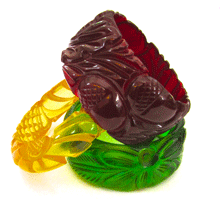
|
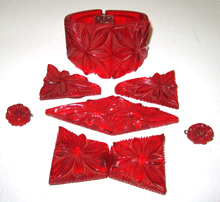
|
|
Three heavily carved bangles: the red bangle shows the sought-after acorn pattern, $500-$600; the apple juice is carved in a desirable pineapple and daisy pattern, $250-$300; and the green bangle has an unusual floral pattern, $300-$350.
|
A nearly complete parure of red Bakelite (or Prystal), including hinge bracelet, a diamond-shaped pin, two dress clips, a pair of earrings and a two-piece buckle. (Bracelet: $375-$450; other pieces, $35-$150. A set of matching pieces can sell for more than the sum of the parts.)
|
The most valuable Bakelite pieces are wide pieces with heavy, deep, and sometimes intricate carving, reverse carving and painting, or with complicated lamination. Dotted pieces are always very popular. Large figurals—pins, necklaces, etc.—have also held onto their value. All of these pieces can go for hundreds, if not thousands, of dollars. But even these special pieces can occasionally be bought at a good price, if you know what to look for.
As a collector looking for authentic pieces, your "toolkit" consists of knowledge of the different plastics, authentic vintage styles, and decorative techniques, as well as fakes and reproductions. You will also need a good sense of smell. Yes, smell! The best test for Bakelite is to rub the item hard until your finger feels warm and then smell it quickly. If the item has transferred a pungent burning odor to your finger, you've hit Bakelite gold! Be careful though. Bakelite is not the only plastic that has an odor: celluloid smells like camphor or vinegar; galalith, like spoiled milk; and some modern resins, like petroleum. It's best to ask a reputable dealer to let you smell a few of their pieces until you get the idea.
|
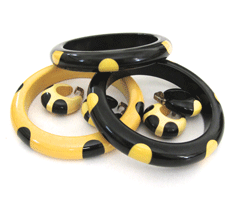
|
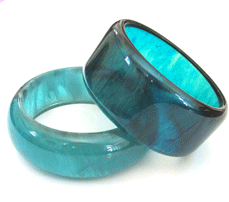
|
|
Black on cream and cream on black, 6-dot bangles and matching earrings. Also shown (top) is a black bangle with offset cream dots; earrings, $80-$125; bangles $200-$350.
|
Two translucent/transparent bangles in unusual blue colors. The wider, lighter one has been refinished. The darker one came from an abandoned Bakelite factory, $250-$350.
|
Don't believe anyone who tells you that "black Bakelite doesn't test." It may not pass chemical tests, but it should pass the smell test. Once you smell that odor, you won't forget it. (For more information on testing, see Plastic Bangles, by Tortoriello and Lyons.) If you don’t have a great smeller, you can dip the piece in hot water and smell it, or use Semichrome polish, which turns from pink to mustard yellow when it comes in contact with oxidized Bakelite.
Bakelite jewelry was very rarely molded, so learning to distinguish pieces that have been hard-carved or turned on a lathe from those that were molded will help you make accurate identifications. Some celluloid bangles were hand-carved, but most were stamped or molded in intricate and highly regular patterns. A hand-carved Bakelite item will show the individuality of the carver and even the occasional over-carving error. Lucite bangles can also be hand-carved but are usually molded or turned on a lathe. While celluloid and Lucite bangles can have seams, Bakelite bangles never do because they were sliced from cast tubes. Hard plastics were also used to make cheap vintage bangles. These make a high-pitched clinking sound and often show whitish areas along their edges, as the plastic breaks down easily. The more of these signs you get to know, the more confident you will be in your buying.
|
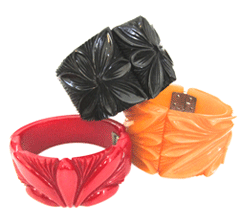
|
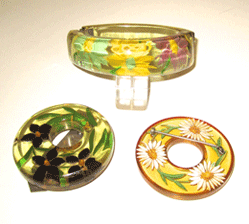
|
|
Three wide hinge bracelets, also known as clampers. Note the oval shape of the openings, $350-$550.
|
A reverse-carved and painted hinge bracelet, pin, and clip. These pieces were all once clear, but have darkened with exposure to light. The hinge bracelet must have been well-stored, as it has suffered remarkably little color change, both to the Bakelite and to the painting; bracelet: $350-$400; pin and clip: $50-$100 each.
|
Learn to recognize authentic pieces by poring over the excellent collectors' books by Davidow and Dawes, Karima Parry, Wasserstrom and Piña, and Battle and Lesser, as well as those written by me and my co-author Lyn Tortoriello (see below). Be aware that nearly every book (even ours!) has one or two misidentified items, but these authors know their stuff. Notice the colors as well. Unless an item has been refinished, it will not be colorless, white, light pink, light blue, or light purple, as oxidation has darkened these colors. In marbled items, the color is distributed in random swirls. Because of the way Bakelite was cast, bands of color can only be achieved by lamination, in which pieces of different colors are glued together.
Around the year 2000, a lot of fake Bakelite ("fakelite") bangles and pins started to flood the market, so the earlier books are the best defense against these fakes. If you see a style that doesn't appear in any of them, be suspicious. Some fakes are well done and even attractive, but most feature ugly colors, often layered around the bangle, unsubtle carving, inauthentic motifs (hands, lips, cats, alligators, etc.), overly chunky shapes, or edges that have been heavily carved away. The inside of a vintage Bakelite bangle will nearly always have a knife edge, but most fakes have a rounded inner lip. Vintage hinge (clamper) bracelets almost always have an oval shape, but the fakes are round, as if someone took a bangle, cut it apart, and added a hinge. Recently, pieces accurately imitating Bakelite patterns have appeared, but they are easily recognized by the look and feel of the plastic, and are usually sold as Lucite. Because of the many retro or vintage-inspired pieces being made now, the collector is well advised to pass by department store jewelry counters and to look at new costume jewelry on eBay to get an idea of the repros being made.
|
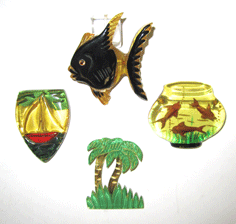
|
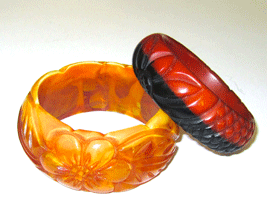
|
|
A group of marine and tropical-themed figural pins. (Clockwise from top) Black and apple juice laminated and carved fish pin, $200-$250; reverse-carved fish bowl, $175-$250; front- and back-carved palm tree pin ($125-$175); top-carved and reverse painted sailboat clip, $60-$85.
|
Two “fakelite” bangles. They both show banded or layered colors around the bangle, which is a clear tip-off that these are not Bakelite. The one on the left is probably Asian in origin. The wide yellow one, which is far chunkier than authentic Bakelite pieces, is in a molded pattern that is found in a wide range of colors. Fakelite bangles are sometimes treated with a chemical that yields an apparent positive result for Bakelite, $15-$25, although seen on eBay for hundreds.
|
Other Plastics. Celluloid was already a popular material for jewelry when Bakelite came on the scene. Unlike Bakelite, it degrades easily. Also unlike Bakelite, it is flexible and lightweight. It can be lovely, and is highly collectible, especially the “sparklers” with rows of rhinestones, some with painted and lightly carved designs.
When Bakelite prices started to rise, many collectors turned to more recent vintage plastics, especially the colorful Lucite pieces popular in the 1950s and 1960s. When they first became collectible, you could easily find them for a few dollars apiece, but now, mass-produced Lucite bangles are fetching upwards of $30 and more. Bangles have had a resurgence in the last 15 years, and a lot of new pieces are in circulation, so it’s important to learn to tell vintage from new. Be careful of pieces that imitate Bakelite patterns, wood and plastic laminates, and chunky free-form bangles. Most of these are not vintage.
Building Your Collection. Once you have done your homework, it’s time to start shopping! Flea markets are a great way to go, but eBay is also a resource. Be careful, though: not all sellers are knowledgeable, so they oversell and overprice their wares. Get your feet wet by tracking the prices of items you like. (Searching completed auctions is a great way to do this.) Some of the most expensive pieces listed are fake; see if you can spot them. Similar items show up at very different prices, so unless a piece is very rare, don’t jump without regard to cost. Even if the seller says they accept no refunds, eBay makes it easy for you to get your money back if the piece is misrepresented or damaged.
|
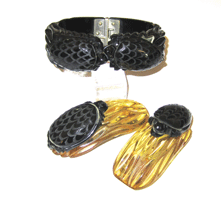
|
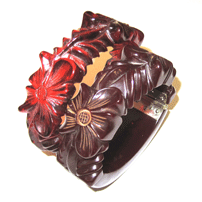
|
|
A black hinge bracelet with two turtles shown with two-toned black and apple juice clips in the same pattern; Bracelet: $350-$450; clips, $100-$175 for the pair.
|
The Bakelite hinge bracelet on the right is shown with a cast resin bangle in the same pattern. The very different textures of the two plastics can be seen; Bakelite bracelet: $300-$375; resin bangle: $15-$25.
|
What should you collect? Whatever you love. For some people, it might be googly-eyed horse pins or brooches dripping with fruit. Others go for rare colors, or the best carving they can find.
Some collectors want the same piece in every color, while others try to assemble matching pieces in the same color. A complete Bakelite parure may consist of bangles in different widths, a hinge bracelet, earrings, pin, pendant, ring, a pair of dress clips, a two-piece buckle, and (rarely) matching buttons. Carved pins and hinge (clamper) bracelets were very much in demand for a while, but now that prices are lower, they present a particularly good collecting opportunity. If you are persistent, you can find small but nicely carved pins for as little as $25 and hinge bracelets for under $150. There’s no harm in starting small but stick to pieces in very good to excellent condition. As you gain experience, you can trade in your beginning pieces for something more ambitious. Whatever you buy, as long as it makes your heart sing, you really can’t go wrong.
---------------------------------------------------
Deborah Lyons is the co-author, with Lyn Tortoriello, of Plastic Bangles (Schiffer Books, 2005) and Bakelite Jewelry: the Art of the Carver (Schiffer Books, 2008). You can find her shop, Banglemania, on Ruby Lane. You can also reach her at basilissa1@gmail.com.
|